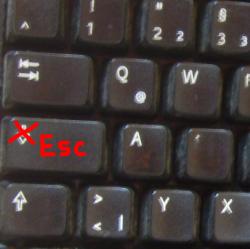Artikel mit Tag keyboard
Sonntag, 10. Juli 2016
Jeopardy!
About two weeks ago, some visitors of the openSUSE Conference enjoyed playing openSUSE Jeopardy.
You might guess that there are some free implementations of the Jeopardy game out there. This is true, but everything I found didn't match my requirements (with varying reasons for each implementation I found). Therefore I decided to improve Ryan McDevitt's JavaScript Jeopardy and added quite some features I wanted to have available for running the openSUSE Jeopardy.
Some technical details:
- the board is implemented using HTML and jQuery, so all you need is a browser (ideally in fullscreen mode)
- the answers and questions are read from JSON files (you can also mark answers as "daily doubles" there)
- everything (except selecting a tile) is done with keyboard shortcuts
- besides the obvious basic features, there are some just for fun additions like the demo runner
I'm happy to announce that I just released my Jeopardy implementation on github under the MIT licence. (Yes, I usually prefer GPL, but since both jQuery and Ryan's original implementation are MIT-licensed, I decided to keep it that way.)
If you want to run a Jeopardy show (with whatever topics) yourself, I hope you find my implementation useful!
I'd also like to thank Hakon from the Linux User Group Landau for soldering a Jeopardy controller using the controller of an old USB keyboard. If you want to do something like that yourself: Dismantle an old keyboard. You'll find a small controller board which is attached to two foils that reach out to the keys. The buzzing is done using the 1..9 keys, so find out which contacts are used for those keys and solder cables on them. Oh, and make sure the cables are long enough to reach out to your players ;-)
Montag, 8. Oktober 2007
vim-freundliche Tastatur
(as special present for everybody coming from my People of openSUSE interview, this post also includes an english translation (green font) ;-)
Ich bin gerade in den Nachrichten :-) Um genau zu sein: Ich wurde für People of openSUSE interviewt. Als kleines Geschenk an alle openSUSE-User hier die Erklärung, wie man seine Tastatur vim-freundlicher macht.

Vim ist dank der Tastaturbedienung der schnellste Editor, den ich kenne. Einzig der weite Weg zur Escape-Taste stört etwas. Linux wäre aber nicht Linux, wenn man die Tastaturbelegung nicht selbst ändern könnte.
Aus meiner Sicht ist CapsLock ziemlich überflüssig. Daher habe ich Escape auf CapsLock verlegt und nutze jetzt die noch überflüssigere Break-Taste für CapsLock.
Die Änderung der Tastaturbelegung ist ziemlich einfach. Zuerst legt man ~/.Xmodmap mit folgendem Inhalt an:
Vim is the fastest editor I know because you can operate it with the keyboard. Only the long distance to the Escape key is annoying. But Linux would not be Linux if you could not change the keyboard mapping yourself.
IMHO the CapsLock key is quite superfluous. Therefore I have mapped Escape to the CapsLock key and use the even more superfluous Break key for CapsLock functionality.
Changing the keyboard mapping is easy. First create ~/.Xmodmap with this content:
!! map CapsLock functionality to the "Break" key
keycode 110 = Caps_Lock
!! map Escape to the CapsLock key
keycode 66 = Escape
!! clear CapsLock and map it on "Break"
clear Lock
add Lock = Caps_Lock
Jetzt muss man nur noch dafür sorgen, dass die .Xmodmap beim Login geladen wird. Da die KDE-Tastatureinstellungen gern mal die Einstellungen der .Xmodmap überschreiben, mache ich das Ganze spät genug mit einem Script im KDE Autostart-Ordner:
Then you have to make sure that .Xmodmap is loaded at login. The KDE keyboard settings tend to overwrite earlier settings, therefore I load my .Xmodmap late enough in a script inside the KDE autostart folder:
xmodmap /home/cb/.Xmodmap
Wenn man auch die virtuellen Konsolen mit dieser Tastaturbelegung bestücken möchte (diesmal ohne die Änderung von Break), legt man die Datei /usr/share/kbd/keymaps/i386/qwertz/escape-capslock.map mit folgendem Inhalt an:
If you want to modify the keymap of the virtual consoles also (this time without changing Break), create the file /usr/share/kbd/keymaps/i386/qwertz/escape-capslock.map with this content:
include "de-latin1-nodeadkeys.map.gz" # enter your local keytable here
keycode 58 = Escape
alt keycode 58 = Meta_Escape
Anschließend ändert man in /etc/sysconfig/keyboard die Tastaturbelegung:
Then change your keyboard layout in /etc/sysconfig/keyboard:
KEYTABLE="escape-capslock.map"
Das wars. Mit dieser kleinen Änderung der Tastaturbelegung lässt es sich mit vim noch bequemer und schneller arbeiten.
That's it. With this little change of the keyboard layout, working with vim is more comfortable and faster.


Kommentare